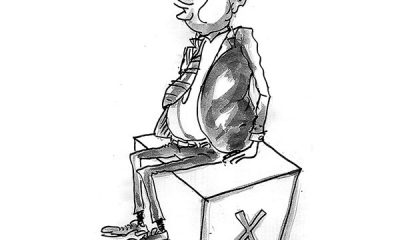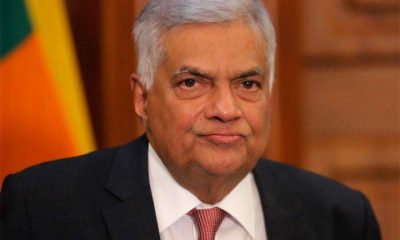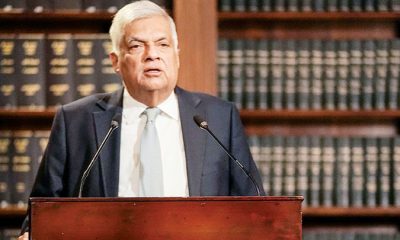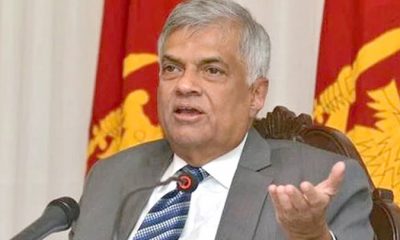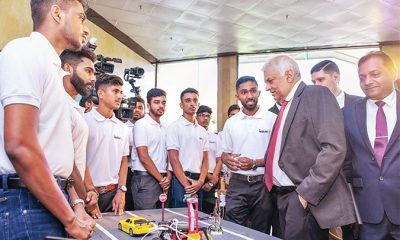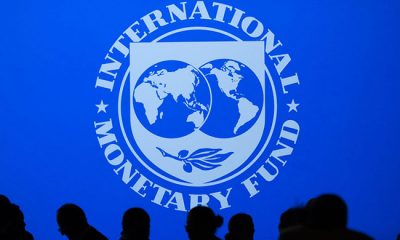Features
What does President Ranil Wickremesinghe have up his sleeve?
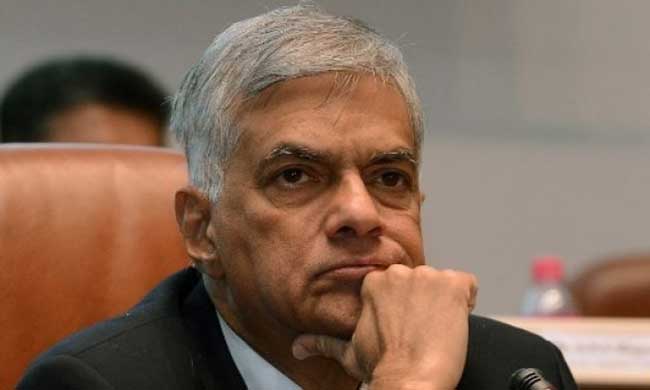
By Rohana R. Wasala
Whatever it is, equipped with his education, native intelligence and acquired political wisdom, he will be able to hold the country as a whole until it passes lawfully into the hands of the uncorrupt patriotic young generation that is waiting in the wings in patient silence (not into those of the ignorant noisy buffoons in the aragalaya.
A number of sacrilegious attacks have been made in recent times on the Sri Dalada (the Sacred Tooth Relic) in Kandy, astonishingly by some Buddhists. Sepala Amerasinghe, an elderly YouTuber, has committed repeated verbal sacrilege; the other instance may be described as a form of desecration of the Sri Dalada Maligawa in Kandy by a kind of faith-healing veda mahattaya/native physician known as Janaka C. Senadhipathi. He is building at Potuhera, Kurunegala, an unauthorised replica of the Sri Dalada Maligawa in Kandy, claiming that the sacred relic will be miraculously transported to his new shrine from the Kandy Sri Dalada Maligawa, which according to him, is polluted by the materialistic corruption of its present custodians). It is ironic that these acts take place (by design or coincidence) only a few days after president Wickremesinghe showed his desire to have a special exposition of the Dalada ahead of the next independence day due to be held in February. The President is obviously hoping to achieve something of tremendous importance for the nation that he seems to think is significant enough to be celebrated with a Dalada exhibition. What this epoch making development probably is not a mystery to adult Sri Lankans who have some idea about the dynamics of post independence politics in Sri Lanka. It must be something to do with the final settlement of the so-called Tamil national problem or the implementation of 13A+.
This confronts the nation with a dilemma concerning Wickremesinghe as everybody’s (225 in parliament’s and the general public’s) refuge/saviour: it is the general public perception that, at this moment, there is no political leader who can at least try to bring about some sort of economic stability to the country except Wickremesinghe. But will he be able to garner enough parliamentary support to implement 13A+? To compound the confusion, there is the problem of holding the lawfully scheduled local government elections, the likely result of which will not strengthen the mutually dependent parliament-president combine, nor benefit the nation economically or politically. The people will question: Why are you so particular about sticking to the electoral laws at this critical juncture where the flagrant violation of other existing vital laws such as the antiquities ordinances has introduced a previously non-existent religious and racial dimension to the country’s political divisions? But be that as it may. Let’s return to our present topic.
Since the arrival of the Tooth Relic in Sri Lanka in the 4th century CE (this is well recorded in the Mahavamsa and other chronicles), a tradition evolved according to which the ruler of the island acquired the legitimacy of his sovereignty by virtue of the possession of the sacred relic. The Dalada was held in a shrine within the palace complex. The shrine itself later came to be called Maligawa or palace, the residence of the king, because of this connection between sovereignty and the sacred relic. Due to this reason, the Dalada was subject to changing hands between external invaders or internal rivals and the reigning monarchs during troubled times, as happened several times before the European advent in the island and after. The desacralisation of the sacred relic and the attempted dilution of the sanctity of the Dalada Maligawa in Kandy could be premeditated. Though it is well known that the Dalada has neither any connection with, nor bears any responsibility for, the current economic and political crises, it has become a target for attack concerning even natural disasters.
Sepala Amerasinghe has been arrested and remanded till January 17, blamed the recent floods in Kandy caused by heavy rains on the Tooth Relic, in one of his videos. This was an oblique reference to the traditionally held belief among Buddhists that the Dalada has rain-making powers. Such beliefs (and relic worship itself for that matter) are not found in Theravada Buddhism, but are imports from the Mahayana tradition which are now part of the local Buddhist religious culture.
So, there seems to be a deliberate attempt by certain inimical forces to dilute or totally negate the symbolic power of the Sacred Tooth Relic for the majority Sinhalese Buddhist polity. It is the bounden duty of the government on behalf of all concerned citizens to investigate what sinister force is behind these incidents and take remedial action. But there are no blasphemy laws in Buddhism.
It was when several concerned lay Buddhists complained to them again about Sepala Amerasinghe repeatedly making sacrilegious statements that the Mahanayake Theras and the Diyawadana Nilame, the guardian of the Maligawa, wrote to the President about it.
Incidentally, Mahinda Rajapaksa seems to be lurking protectively behind Senadhipathi. The former’s erstwhile sidekick Mervin Silva visited Potuhera, and ordered the demolition of the front part of the building in question, declaring that there should be only one Dalada Maligawa, the one in Kandy and that the rest of the structures in the place must remain.
Silva is reported to have threatened with death social activist Nilantha Ranasinghe, who raised the issue in public and exposed Senadhipathi’s questionable activities with audio, video and print evidence. Mervin Silva told another YouTuber (named Chaturanga Bandara) that Mahinda Rajapaksa had phoned him to thank him for what he did.) Mahinda exploited the nationalist groundswell to sweep the 2019 presidential and 2020 parliamentary elections against the previous infamous yahapalanaya led by prime minister Ranil Wickremesinghe and president Maithripala Sirisena; but he totally betrayed that victory through the entrenched corruption he supported among his stooges and his own obsession with dynastic rule, which ultimately brought repeatedly rejected Wickremesinghe to the helm. Mahinda seems to have so morally weakened as to make a futile attempt to salvage his lost popularity among the Buddhist voters by championing fake ‘Bosath’ Janaka Senadhipathi, with the help of thuggish Mervin.
To return to the beginning, the media reported (December 24, 2022) that a request that President Wickremesinghe made for a special exposition of the Sacred Tooth Relic before February 2023 when Sri Lanka completes seventy-five years of independence did not get a positive response from either of the two Ven. Mahanayake Theras of the Siam Nikaya, Malwatte and Asgiriya chapters, in Kandy, who are joint custodians of the Sri Dalada Maligawa. The P resident’s request was conveyed to the prelates in a letter from him personally delivered to them by prime minister Dinesh Gunawardane, who expressly called on them for the purpose. The Malwatte prelate, according to the news reports, suggested that the PM should approach the Asgiriya Mahanayake Thera about this as it is the latter’s turn at the moment to be in charge of the service at the Dalada Maligawa. When the premier visited the Asgiriya Mahanayake Thera with the President’s proposal or appeal, the latter wonderingly asked him if a Tooth Relic exposition at this juncture wasn’t a difficult task to perform.
With hindsight one would hazard a guess that the two Buddhist prelates of the Siam Nikaya, namely the Most Venerable Thibbatuwawe Sri Siddhartha Sumangala Thera of the Malwatte Chapter and the Most Venerable Warakagoda Sri Gnanarathana Thera of the Asgiriya Chapter, especially the former, might accommodate the presidential wish if Buddhist public opinion also favours it. There are two other nikayasm (chapters), Ramanna and Amarapura, which signed an agreement to merge in August 2019; the expected merger was a step in the right direction, for the Maha Sangha unity is indispensable for the survival of the Buddhasasanaya as a religious cultural establishment. The living component of the Buddhasasanaya is ’ the sivvanak pirisa or the fourfold community of male and bhikkus and bhikkunis lay Buddhists. This is not a political entity, but a religious one though it needs state protection (just as it enjoyed full royal patronage under Sinhala kings before the time of foreign invasions); in this, the Sinhala Buddhist community is not different from other religious communities. (In Sri Lanka, 70% of the ethnically and religiously diverse total population comprise Buddhists.) No religion is more compatible with the best form of government evolved to date democracy than Buddhism, though it is not your average religion. Bhikkhus and Bhikkhunis may personally hold different political views, and even exercise their voting rights as they please, as citizens, but it is not proper for them to engage in partisan politics, because that would definitely cause divisions within the fourfold community of Buddhists. The clergy must leave active politics involving campaigning and electioneering entirely to the lay Buddhists. May the Mahanayakes have the wisdom to tell the president not to desecrate the Sri Dalada by dragging it into politics.
However, traditionally and historically, Buddhist monks have wielded great power over the Buddhist community including the rulers. Currently though, they are becoming increasingly powerless, mainly because of their meddling in politics, patronising corrupt politicians, and also because of the Mahanayake Theras’ incomprehensible inaction and disunity. President Wickremesinghe’s seemingly cynical suggestion must be viewed in this context. Is he, through having a special Tooth Relic exposition held to coincide with the implementation of whatever solution he proposes to the Tamil ethnic problem, trying to make palatable to the Sinhala Buddhist majority something they would not normally look upon with favour. Is he bringing back an earlier unpopular deal that sent him and his party home at the hustings? But Ranil is too intelligent to repeat past errors.
I am tempted to say this because Wickremesinghe, unlike his predecessors Mahinda Rajapaksa and Maithripala Sirisena, does not usually make a show of unfelt religious piety for hoodwinking the masses. If he wants, he uses religion in a more street-smart way. Unlike the latter duo again, he is no religious hypocrite; he doesn’t even care to show if he is really a Buddhist (which of course is right, and befits a genuine Buddhist).
The important thing, I think, is that he seems to know that ordinary Buddhist voters, true to their faith, do not worry too much about whether he is a Buddhist or a non-Buddhist. (Unfortunately, however, global scale media distortion against them demonizes Sinhalese Buddhists as racist chauvinists and religious fanatics simply because circumstances force them to raise their voice when their human rights are violated by others (such as unethical conversion of Buddhists, encroachment or vandalizing or desecration of Buddhist archaeological sites, deliberate distortion of historical and Buddhist doctrinal facts).
What is happening in Sri Lanka in this respect, hardly recognized or taken seriously by the global powers that be, is doubtlessly a crime against humanity carried out by an externally well-funded medley of subversive organizations and individuals, that is getting more and more explicit and more and more overpowering in the Sri Lanka’s present economically and politically debilitated situation. It can be argued that the same forces that are behind this insidious barbarity are at least partly responsible for worsening the political and economic maelstrom that is currently engulfing Sri Lanka, despite the abundance of rich natural resources and the high quality of the human resources locally available, both of which its citizens can be justly proud of.
For president Wickremesinghe to want a special Dalada exposition he must be contemplating to consecrate, as it were, something momentous like a nationally important historic event concurrently with government celebrations that will mark the completion of seventy-five years of independence (whatever the last word is held to mean) from British colonial occupation. When it comes to true freedom from Britain, we believe that the 1948 independence was eclipsed by the promulgation of the republican constitution in 1972 under the United Front government of Mrs Sirima Bandaranaike. Yet, it looks like that Wickremesinghe wants to return to the Western fold by ignoring the 1972 change, which was not supported by the Illankei Tamil Arasu Kachchi (Lanka Tamil Kingdom/State Party/or misleadingly called the Federal Party in English) founded in 1949 by S. J. V. Chelvanayagam, an immigrant Tamil from Malaysia. (The clamour for a separate state for Tamils started soon after the grant of so-called independence, which was actually nothing more than dominion status. The 1972 declaration of Ceylon (as Sri Lanka was until then known among foreigners and English-speaking locals) as a republic severed that last link with the British empire.
Sri Lankans are a democratic people. Ranil Wickremesinghe or any other political leader could easily accommodate the legitimate interests of the global and regional superpowers that the country’s geographical location makes it obligatory for it to satisfy, if he did it with the people’s full democratic approval, while at the same time preserving their national dignity, sovereignty and independence.
When in 2019 Wickremesinghe and the UNP that he still leads got kicked out of parliament, he had spent forty-two years in that august body as elected member serving repeatedly in responsible senior positions over that long period as cabinet minister, opposition leader, and prime minister, and now as president at least by default. Ranil Wickremesinghe the politician has nothing more to win or lose in his life; he has nothing to look forward to, except perhaps a dignified obituary. But he suddenly finds ‘greatness thrust upon him’ by a strange turn of events in a context where Sri Lankans of all religious and political persuasions are up against the wall economically and politically. The Sinhalese Buddhists, in addition to this adverse global predicament experienced, not only in Sri Lanka, but across most of the world outside, are simply facing a form of cultural genocide as argued above. It is expediently connived at by our corrupt traitorous self-seeking politicians and blithely indulged by an apparently unconcerned, blissfully ignorant Maha Sangha.
Ranil Wickremesinghe can still use his intellectual superiority and political acumen to rescue our nation.
Features
The heart-friendly health minister

by Dr Gotabhya Ranasinghe
Senior Consultant Cardiologist
National Hospital Sri Lanka
When we sought a meeting with Hon Dr. Ramesh Pathirana, Minister of Health, he graciously cleared his busy schedule to accommodate us. Renowned for his attentive listening and deep understanding, Minister Pathirana is dedicated to advancing the health sector. His openness and transparency exemplify the qualities of an exemplary politician and minister.
Dr. Palitha Mahipala, the current Health Secretary, demonstrates both commendable enthusiasm and unwavering support. This combination of attributes makes him a highly compatible colleague for the esteemed Minister of Health.
Our discussion centered on a project that has been in the works for the past 30 years, one that no other minister had managed to advance.
Minister Pathirana, however, recognized the project’s significance and its potential to revolutionize care for heart patients.
The project involves the construction of a state-of-the-art facility at the premises of the National Hospital Colombo. The project’s location within the premises of the National Hospital underscores its importance and relevance to the healthcare infrastructure of the nation.
This facility will include a cardiology building and a tertiary care center, equipped with the latest technology to handle and treat all types of heart-related conditions and surgeries.
Securing funding was a major milestone for this initiative. Minister Pathirana successfully obtained approval for a $40 billion loan from the Asian Development Bank. With the funding in place, the foundation stone is scheduled to be laid in September this year, and construction will begin in January 2025.
This project guarantees a consistent and uninterrupted supply of stents and related medications for heart patients. As a result, patients will have timely access to essential medical supplies during their treatment and recovery. By securing these critical resources, the project aims to enhance patient outcomes, minimize treatment delays, and maintain the highest standards of cardiac care.
Upon its fruition, this monumental building will serve as a beacon of hope and healing, symbolizing the unwavering dedication to improving patient outcomes and fostering a healthier society.We anticipate a future marked by significant progress and positive outcomes in Sri Lanka’s cardiovascular treatment landscape within the foreseeable timeframe.
Features
A LOVING TRIBUTE TO JESUIT FR. ALOYSIUS PIERIS ON HIS 90th BIRTHDAY

by Fr. Emmanuel Fernando, OMI
Jesuit Fr. Aloysius Pieris (affectionately called Fr. Aloy) celebrated his 90th birthday on April 9, 2024 and I, as the editor of our Oblate Journal, THE MISSIONARY OBLATE had gone to press by that time. Immediately I decided to publish an article, appreciating the untiring selfless services he continues to offer for inter-Faith dialogue, the renewal of the Catholic Church, his concern for the poor and the suffering Sri Lankan masses and to me, the present writer.
It was in 1988, when I was appointed Director of the Oblate Scholastics at Ampitiya by the then Oblate Provincial Fr. Anselm Silva, that I came to know Fr. Aloy more closely. Knowing well his expertise in matters spiritual, theological, Indological and pastoral, and with the collaborative spirit of my companion-formators, our Oblate Scholastics were sent to Tulana, the Research and Encounter Centre, Kelaniya, of which he is the Founder-Director, for ‘exposure-programmes’ on matters spiritual, biblical, theological and pastoral. Some of these dimensions according to my view and that of my companion-formators, were not available at the National Seminary, Ampitiya.
Ever since that time, our Oblate formators/ accompaniers at the Oblate Scholasticate, Ampitiya , have continued to send our Oblate Scholastics to Tulana Centre for deepening their insights and convictions regarding matters needed to serve the people in today’s context. Fr. Aloy also had tried very enthusiastically with the Oblate team headed by Frs. Oswald Firth and Clement Waidyasekara to begin a Theologate, directed by the Religious Congregations in Sri Lanka, for the contextual formation/ accompaniment of their members. It should very well be a desired goal of the Leaders / Provincials of the Religious Congregations.
Besides being a formator/accompanier at the Oblate Scholasticate, I was entrusted also with the task of editing and publishing our Oblate journal, ‘The Missionary Oblate’. To maintain the quality of the journal I continue to depend on Fr. Aloy for his thought-provoking and stimulating articles on Biblical Spirituality, Biblical Theology and Ecclesiology. I am very grateful to him for his generous assistance. Of late, his writings on renewal of the Church, initiated by Pope St. John XX111 and continued by Pope Francis through the Synodal path, published in our Oblate journal, enable our readers to focus their attention also on the needed renewal in the Catholic Church in Sri Lanka. Fr. Aloy appreciated very much the Synodal path adopted by the Jesuit Pope Francis for the renewal of the Church, rooted very much on prayerful discernment. In my Religious and presbyteral life, Fr.Aloy continues to be my spiritual animator / guide and ongoing formator / acccompanier.
Fr. Aloysius Pieris, BA Hons (Lond), LPh (SHC, India), STL (PFT, Naples), PhD (SLU/VC), ThD (Tilburg), D.Ltt (KU), has been one of the eminent Asian theologians well recognized internationally and one who has lectured and held visiting chairs in many universities both in the West and in the East. Many members of Religious Congregations from Asian countries have benefited from his lectures and guidance in the East Asian Pastoral Institute (EAPI) in Manila, Philippines. He had been a Theologian consulted by the Federation of Asian Bishops’ Conferences for many years. During his professorship at the Gregorian University in Rome, he was called to be a member of a special group of advisers on other religions consulted by Pope Paul VI.
Fr. Aloy is the author of more than 30 books and well over 500 Research Papers. Some of his books and articles have been translated and published in several countries. Among those books, one can find the following: 1) The Genesis of an Asian Theology of Liberation (An Autobiographical Excursus on the Art of Theologising in Asia, 2) An Asian Theology of Liberation, 3) Providential Timeliness of Vatican 11 (a long-overdue halt to a scandalous millennium, 4) Give Vatican 11 a chance, 5) Leadership in the Church, 6) Relishing our faith in working for justice (Themes for study and discussion), 7) A Message meant mainly, not exclusively for Jesuits (Background information necessary for helping Francis renew the Church), 8) Lent in Lanka (Reflections and Resolutions, 9) Love meets wisdom (A Christian Experience of Buddhism, 10) Fire and Water 11) God’s Reign for God’s poor, 12) Our Unhiddden Agenda (How we Jesuits work, pray and form our men). He is also the Editor of two journals, Vagdevi, Journal of Religious Reflection and Dialogue, New Series.
Fr. Aloy has a BA in Pali and Sanskrit from the University of London and a Ph.D in Buddhist Philosophy from the University of Sri Lankan, Vidyodaya Campus. On Nov. 23, 2019, he was awarded the prestigious honorary Doctorate of Literature (D.Litt) by the Chancellor of the University of Kelaniya, the Most Venerable Welamitiyawe Dharmakirthi Sri Kusala Dhamma Thera.
Fr. Aloy continues to be a promoter of Gospel values and virtues. Justice as a constitutive dimension of love and social concern for the downtrodden masses are very much noted in his life and work. He had very much appreciated the commitment of the late Fr. Joseph (Joe) Fernando, the National Director of the Social and Economic Centre (SEDEC) for the poor.
In Sri Lanka, a few religious Congregations – the Good Shepherd Sisters, the Christian Brothers, the Marist Brothers and the Oblates – have invited him to animate their members especially during their Provincial Congresses, Chapters and International Conferences. The mainline Christian Churches also have sought his advice and followed his seminars. I, for one, regret very much, that the Sri Lankan authorities of the Catholic Church –today’s Hierarchy—- have not sought Fr.
Aloy’s expertise for the renewal of the Catholic Church in Sri Lanka and thus have not benefited from the immense store of wisdom and insight that he can offer to our local Church while the Sri Lankan bishops who governed the Catholic church in the immediate aftermath of the Second Vatican Council (Edmund Fernando OMI, Anthony de Saram, Leo Nanayakkara OSB, Frank Marcus Fernando, Paul Perera,) visited him and consulted him on many matters. Among the Tamil Bishops, Bishop Rayappu Joseph was keeping close contact with him and Bishop J. Deogupillai hosted him and his team visiting him after the horrible Black July massacre of Tamils.
Features
A fairy tale, success or debacle

Sri Lanka-Singapore Free Trade Agreement
By Gomi Senadhira
senadhiragomi@gmail.com
“You might tell fairy tales, but the progress of a country cannot be achieved through such narratives. A country cannot be developed by making false promises. The country moved backward because of the electoral promises made by political parties throughout time. We have witnessed that the ultimate result of this is the country becoming bankrupt. Unfortunately, many segments of the population have not come to realize this yet.” – President Ranil Wickremesinghe, 2024 Budget speech
Any Sri Lankan would agree with the above words of President Wickremesinghe on the false promises our politicians and officials make and the fairy tales they narrate which bankrupted this country. So, to understand this, let’s look at one such fairy tale with lots of false promises; Ranil Wickremesinghe’s greatest achievement in the area of international trade and investment promotion during the Yahapalana period, Sri Lanka-Singapore Free Trade Agreement (SLSFTA).
It is appropriate and timely to do it now as Finance Minister Wickremesinghe has just presented to parliament a bill on the National Policy on Economic Transformation which includes the establishment of an Office for International Trade and the Sri Lanka Institute of Economics and International Trade.
Was SLSFTA a “Cleverly negotiated Free Trade Agreement” as stated by the (former) Minister of Development Strategies and International Trade Malik Samarawickrama during the Parliamentary Debate on the SLSFTA in July 2018, or a colossal blunder covered up with lies, false promises, and fairy tales? After SLSFTA was signed there were a number of fairy tales published on this agreement by the Ministry of Development Strategies and International, Institute of Policy Studies, and others.
However, for this article, I would like to limit my comments to the speech by Minister Samarawickrama during the Parliamentary Debate, and the two most important areas in the agreement which were covered up with lies, fairy tales, and false promises, namely: revenue loss for Sri Lanka and Investment from Singapore. On the other important area, “Waste products dumping” I do not want to comment here as I have written extensively on the issue.
1. The revenue loss
During the Parliamentary Debate in July 2018, Minister Samarawickrama stated “…. let me reiterate that this FTA with Singapore has been very cleverly negotiated by us…. The liberalisation programme under this FTA has been carefully designed to have the least impact on domestic industry and revenue collection. We have included all revenue sensitive items in the negative list of items which will not be subject to removal of tariff. Therefore, 97.8% revenue from Customs duty is protected. Our tariff liberalisation will take place over a period of 12-15 years! In fact, the revenue earned through tariffs on goods imported from Singapore last year was Rs. 35 billion.
The revenue loss for over the next 15 years due to the FTA is only Rs. 733 million– which when annualised, on average, is just Rs. 51 million. That is just 0.14% per year! So anyone who claims the Singapore FTA causes revenue loss to the Government cannot do basic arithmetic! Mr. Speaker, in conclusion, I call on my fellow members of this House – don’t mislead the public with baseless criticism that is not grounded in facts. Don’t look at petty politics and use these issues for your own political survival.”
I was surprised to read the minister’s speech because an article published in January 2018 in “The Straits Times“, based on information released by the Singaporean Negotiators stated, “…. With the FTA, tariff savings for Singapore exports are estimated to hit $10 million annually“.
As the annual tariff savings (that is the revenue loss for Sri Lanka) calculated by the Singaporean Negotiators, Singaporean $ 10 million (Sri Lankan rupees 1,200 million in 2018) was way above the rupees’ 733 million revenue loss for 15 years estimated by the Sri Lankan negotiators, it was clear to any observer that one of the parties to the agreement had not done the basic arithmetic!
Six years later, according to a report published by “The Morning” newspaper, speaking at the Committee on Public Finance (COPF) on 7th May 2024, Mr Samarawickrama’s chief trade negotiator K.J. Weerasinghehad had admitted “…. that forecasted revenue loss for the Government of Sri Lanka through the Singapore FTA is Rs. 450 million in 2023 and Rs. 1.3 billion in 2024.”
If these numbers are correct, as tariff liberalisation under the SLSFTA has just started, we will pass Rs 2 billion very soon. Then, the question is how Sri Lanka’s trade negotiators made such a colossal blunder. Didn’t they do their basic arithmetic? If they didn’t know how to do basic arithmetic they should have at least done their basic readings. For example, the headline of the article published in The Straits Times in January 2018 was “Singapore, Sri Lanka sign FTA, annual savings of $10m expected”.
Anyway, as Sri Lanka’s chief negotiator reiterated at the COPF meeting that “…. since 99% of the tariffs in Singapore have zero rates of duty, Sri Lanka has agreed on 80% tariff liberalisation over a period of 15 years while expecting Singapore investments to address the imbalance in trade,” let’s turn towards investment.
Investment from Singapore
In July 2018, speaking during the Parliamentary Debate on the FTA this is what Minister Malik Samarawickrama stated on investment from Singapore, “Already, thanks to this FTA, in just the past two-and-a-half months since the agreement came into effect we have received a proposal from Singapore for investment amounting to $ 14.8 billion in an oil refinery for export of petroleum products. In addition, we have proposals for a steel manufacturing plant for exports ($ 1 billion investment), flour milling plant ($ 50 million), sugar refinery ($ 200 million). This adds up to more than $ 16.05 billion in the pipeline on these projects alone.
And all of these projects will create thousands of more jobs for our people. In principle approval has already been granted by the BOI and the investors are awaiting the release of land the environmental approvals to commence the project.
I request the Opposition and those with vested interests to change their narrow-minded thinking and join us to develop our country. We must always look at what is best for the whole community, not just the few who may oppose. We owe it to our people to courageously take decisions that will change their lives for the better.”
According to the media report I quoted earlier, speaking at the Committee on Public Finance (COPF) Chief Negotiator Weerasinghe has admitted that Sri Lanka was not happy with overall Singapore investments that have come in the past few years in return for the trade liberalisation under the Singapore-Sri Lanka Free Trade Agreement. He has added that between 2021 and 2023 the total investment from Singapore had been around $162 million!
What happened to those projects worth $16 billion negotiated, thanks to the SLSFTA, in just the two-and-a-half months after the agreement came into effect and approved by the BOI? I do not know about the steel manufacturing plant for exports ($ 1 billion investment), flour milling plant ($ 50 million) and sugar refinery ($ 200 million).
However, story of the multibillion-dollar investment in the Petroleum Refinery unfolded in a manner that would qualify it as the best fairy tale with false promises presented by our politicians and the officials, prior to 2019 elections.
Though many Sri Lankans got to know, through the media which repeatedly highlighted a plethora of issues surrounding the project and the questionable credentials of the Singaporean investor, the construction work on the Mirrijiwela Oil Refinery along with the cement factory began on the24th of March 2019 with a bang and Minister Ranil Wickremesinghe and his ministers along with the foreign and local dignitaries laid the foundation stones.
That was few months before the 2019 Presidential elections. Inaugurating the construction work Prime Minister Ranil Wickremesinghe said the projects will create thousands of job opportunities in the area and surrounding districts.
The oil refinery, which was to be built over 200 acres of land, with the capacity to refine 200,000 barrels of crude oil per day, was to generate US$7 billion of exports and create 1,500 direct and 3,000 indirect jobs. The construction of the refinery was to be completed in 44 months. Four years later, in August 2023 the Cabinet of Ministers approved the proposal presented by President Ranil Wickremesinghe to cancel the agreement with the investors of the refinery as the project has not been implemented! Can they explain to the country how much money was wasted to produce that fairy tale?
It is obvious that the President, ministers, and officials had made huge blunders and had deliberately misled the public and the parliament on the revenue loss and potential investment from SLSFTA with fairy tales and false promises.
As the president himself said, a country cannot be developed by making false promises or with fairy tales and these false promises and fairy tales had bankrupted the country. “Unfortunately, many segments of the population have not come to realize this yet”.
(The writer, a specialist and an activist on trade and development issues . )


